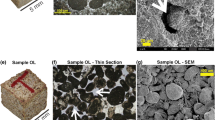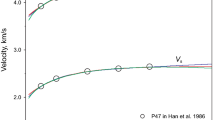Abstract
Compressional and shear-wave velocities (V p andV s) of 210 minicores of carbonates from different areas and ages were measured under variable confining and pore-fluid pressures. The lithologies of the samples range from unconsolidated carbonate mud to completely lithified limestones. The velocity measurements enable us to relate velocity variations in carbonates to factors such as mineralogy, porosity, pore types and density and to quantify the velocity effects of compaction and other diagenetic alterations.
Pure carbonate rocks show, unlike siliciclastic or shaly sediments, little direct correlation between acoustic properties (V p andV s) with age or burial depth of the sediments so that velocity inversions with increasing depth are common. Rather, sonic velocity in carbonates is controlled by the combined effect of depositional lithology and several post-depositional processes, such as cementation or dissolution, which results in fabrics specific to carbonates. These diagenetic fabrics can be directly correlated to the sonic velocity of the rocks.
At 8 MPa effective pressureV p ranges from 1700 to 6500 m/s, andV s ranges from 800 to 3400 m/s. This range is mainly caused by variations in the amount and type of porosity and not by variations in mineralogy. In general, the measured velocities show a positive correlation with density and an inverse correlation with porosity, but departures from the general trends of correlation can be as high as 2500 m/s. These deviations can be explained by the occurrence of different pore types that form during specific diagenetic phases. Our data set further suggests that commonly used correlations like “Gardner's Law” (V p-density) or the “time-average-equation” (V p-porosity) should be significantly modified towards higher velocities before being applied to carbonates.
The velocity measurements of unconsolidated carbonate mud at different stages of experimental compaction show that the velocity increase due to compaction is lower than the observed velocity increase at decreasing porosities in natural rocks. This discrepancy shows that diagenetic changes that accompany compaction influence velocity more than solely compaction at increasing overburden pressure.
The susceptibility of carbonates to diagenetic changes, that occur far more quickly than compaction, causes a special velocity distribution in carbonates and complicates velocity estimations. By assigning characteristic velocity patterns to the observed diagenetic processes, we are able to link sonic velocity to the diagenetic stage of the rock.
Similar content being viewed by others
References
Anselmetti, F. S., Eberli, G. P., Sellami, S., andBernoulli, D.,From outcrops to seismic profiles: An attempt to model the carbonate platform margin of the Maiella, Italy. InAbstract with Programs (Geol. Society of America, Annual Meeting, San Diego 1991).
Biddle, K. V., Schlager, W., Rudolph, K. W., andBush, T. L. (1992),Seismic Model of a Progradational Carbonate Platform, Picco di Vallandro, the Dolomites, Northern Italy, American Association of Petroleum Geologists Bull.76, 14–30.
Biot, M. A. (1956),Theory of Propagation of Elastic Waves in a Fluid-saturated Porous Solid, I. Low Frequency Range, II. Higher Frequency Range, J. Acoust. Soc. Am.28, 168–191.
Birch, F. (1960),The Velocity of Compressional Waves in Rocks to 10 Kilobars, Part 1, J. Geophys. Res.65, 1083–1102.
Burns, S. J., andSwart, P. K. (1992),Diagenetic Processes in Holocene Carbonate Sediments: Florida Bay Mudbanks and Islands, Sedimentology39, 285–304.
Campbell, A. E., andStafleu, J. (1992),Seismic Modelling of an Early Jurassic, Drowned Platform: The Djebel Bou Dahar, High Atlas, Morocco, American Association of Petroleum Geologists Bull.76, 1760–1777.
Christensen, N. I., andSzymanski, D. L. (1991),Seismic Properties and the Origin of Reflectivity from a Classic Palsozoic Sedimentary Sequence, Valley and Ridge Province, Southern Appalachians, Geol. Soc. Am. Bull.103, 277–289.
Coyner, K. B. (1984),Effects of Stress, Pore Pressure, and Pore-fluids on Bulk Strain, Velocity and Permeability in Rocks (Ph.D. Thesis, Massachusetts Institute of Technology).
Crescenti, U., Crostella, A., Donzelli, G., andRaffi, G. (1969),Stratigrafia della serie calcarea dal Lias al Miocene nella regione Marchigiano-Abruzzese, Parte II—Litostratigrafia, Biostratigrafia, Paleogeografia, Mem. Soc. Geol. It.8, 343–420.
Dawans, J. M., andSwart, P. K. (1988),Textural and Geochemical Alterations in Late Cenozoic Bahamian Dolomites, Sedimentology35, 385–403.
Eberli, G. P.,Physical properties of carbonate turbidite sequences surrounding the Bahamas: Implications for slope stability and fluid movements. InProceedings of the Ocean Drilling Program, Scientific Results 101 (eds. Austin, J. A., Jr., and Schlager, W.) (1988) pp. 305–314.
Eberli, G. P., andGinsburg, R. N.,Cenozoic progradation of Northwestern Great Bahama Bank, a record of lateral platform growth and sea-level fluctuations. InControls on Carbonate Platform and Basin Development (SEPM Special Publication No. 44 1989) pp. 339–351.
Eberli, G. P.,Growth and demise of isolated carbonate platforms: Bahamian controversies. InControversies in Modern Geology (Academic Press Limited 1991) pp. 231–248.
Eberli, G. P., Bernoulli, D., Sanders, D., andVecsei, A. (1993),From aggradation to progradation: The Maiella platform (Abruzzi, Italy). InAtlas of Cretaceous Carbonate Platforms (eds. Simo, J. T., Scott, R. W., and Masse, J.-P.) Amer. Assoc. of Petroleum Geologist Memoir56, 213–232.
Enos, P., andSawatsky, L. H. (1981),Pore Networks in Holocene Carbonate Sediments, J. Sed. Petrol.51, 961–985.
Enos, P., andPerkins, R. D. (1979),Evolution of Florida Bay from Island Stratigraphy, Geol. Soc. Am. Bull.90, 59–83.
Gardner, G. H. F., Gardner, L. W., andGregory, A. R. (1974),Formation Velocity and Density: The Diagnostic Basics for Stratigraphic Traps, Geophysics39, 770–780.
Gassmann, F. (1951),Elastic Waves through a Packing of Spheres, Geophysics16, 673–685.
Hamilton, E. L. (1971),Elastic Properties of Marine Sediments, J. Geophys. Res.76/2, 579–604.
Hamilton, E. L., (1980),Geoacoustic Modeling of the Sea-floor, J. Acoust. Soc. Am.68, 1313–1340.
Japsen, P. (1993),Influence of Lithology and Neogene Uplift on Seismic Velocities in Denmark: Implications for Depth Conversion of Maps, American Association of Petroleum Geologists Bull.77, 194–211.
Kenter, J. A. M., Ginsburg, R. N., Eberli, G. P. McNeill, D. F., andLidz, B. H. (1991),Mio-Pliocene Sea-level Fluctuations Recorded in Core Borings from the Western Margin of Great Bahama Bank, Abstract, GSA Annual Meeting, San Diego, California.
Laughton, A. S. (1957),Sound Propagation in Compacted Ocean Sediments, Geophysics22, 233–260.
Marion, D., Nur, A., Yin, H., andHan, D. (1992),Compressional Velocity and Porosity in Sand-clay Mixtures, Geophysics57, 554–563.
Milholland, P., Manghani, M. H., Schlanger, S. O., andSutton, G. H. (1980),Geoacoustic Modeling of Deep-sea Carbonate Sediments, J. Acoust. Soc. Am.68/5, 1351–1360.
Nur, A., andSimmons, G. (1969),The Effect of Saturation on Velocity in Low Porosity Rocks, Earth and Planet. Sci. Lett.7, 183–193.
Nur, A., Marion, D., andYin, H.,Wave velocities in sediments. InShear Waves in Marine Sediments (Kluwer Academic Publishers 1991) pp. 131–140.
Rafavich, F., Kendall, C. H. St. C., andTodd, T. P. (1984),The Relationship between Acoustic Properties and the Petrographic Character of Carbonate Rocks, Geophysics49, 1622–1636.
Sanders, D. G. K. (1994),The Cenomanian to Miocene Evolution of a Carbonate Platform to Basin Transition: Montagna della Maiella Abruzzi, Italy (unpubl. Diss. ETH Zürich, Switzerland).
Schlanger, S. O., andDouglas, R. G.,The pelagic ooze-chalk-limestone transition and its implications for marine stratigraphy. InPelagic Sediments (eds. Hsu, K. J., and Jenkyns, H. C.) (Special Publication Int. Assoc. of Sedimentologists 1 1974) pp. 117–148.
Sellami, S., Barblan, F., Mayerat, A.-M., Pfiffner O. A., Risnes, K., andWagner, J.-J. (1990),Compressional Wave Velocities of Samples from the NFP-20 East Seismic Reflection Profile, Mém. Soc. Géol. Suisse1, 77–84.
Urmos, J., andWilkens, R. H., (1993),In situ Velocities in Pelagic Carbonates: New Insights from Ocean Drilling Program Leg 130, Ontong Java Plateau, J. Geophys. Res.98/B5, 7903–7920.
Vecsei, A. (1991),Aggradation und Progradation eines Karbonatplattform-Randes: Kreide bis Mittleres Tertiär der Montagna della Maiella, Abruzzen, Mitteilungen aus dem Geologischen Institut der Eigdenössischen Technischen Hochschule und der Universität Zürich, 294.
Vernik, L., andNur, A. (1992),Petrophysical Classification of Siliciclastics for Lithology and Porosity Prediction from Seismic Velocities, American Association of Petroleum Geologists Bull.76, 1295–1309.
Vidlock, S. (1983),The Stratigraphy and Sedimentation of Cluett Key, Florida Bay, M.S. Thesis, University of Connecticut.
Wang, Z., Hirsche, W. K., andSedgwick, G. (1991),Seismic Velocities in Carbonate Rocks, J. Can. Petr. Tech.30, 112–122.
Wilkens, R. H., Fryer, G. F., andKarsten, J. (1991),Evolution of Porosity and Seismic Structure of Upper Oceanic Crust: Importance of Aspect Ratios, J. Geophys. Res.96, 17981–17995.
Wilson, J. L.,Carbonate Facies in Geologic History (Springer, New York 1975).
Wood, A. B. (1941),A Textbook of Sound (Macmillan, New York 1941).
Wyllie, M. R., Gregory, A. R., andGardner, G. H. F. (1956),Elastic Wave Velocities in Heterogeneous and Porous Media, Geophysics21/1, 41–70.
Author information
Authors and Affiliations
Rights and permissions
About this article
Cite this article
Anselmetti, F.S., Eberli, G.P. Controls on sonic velocity in carbonates. PAGEOPH 141, 287–323 (1993). https://doi.org/10.1007/BF00998333
Received:
Revised:
Accepted:
Issue Date:
DOI: https://doi.org/10.1007/BF00998333




